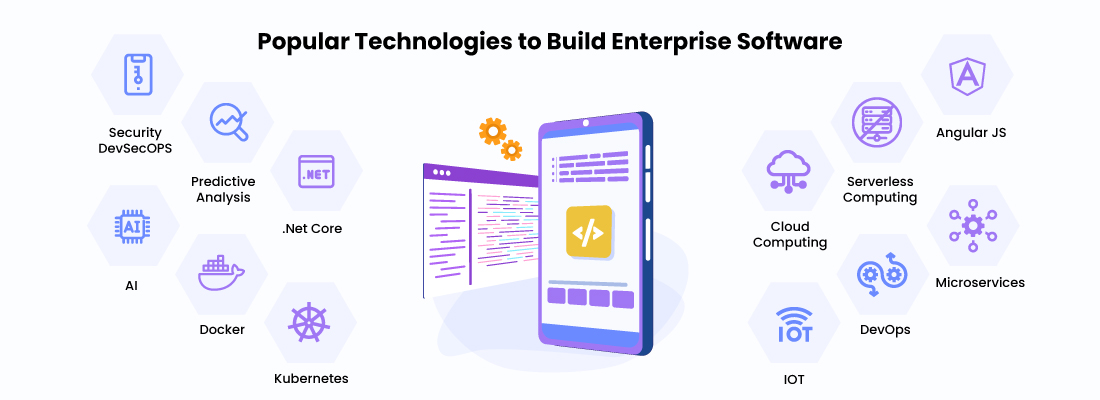Enterprise application development is a complicated but vital procedure that involves creating applications to address the specific needs and difficulties of organizations.
Whether it’s maximizing internal processes, enhancing customer experiences, or simplifying data management, creating effective enterprise applications requires careful preparation and execution.
To achieve this, certain key ingredients come into play, forming the basis for a strong and efficient application.
In this article, we will explore some essential elements that contribute to the success of enterprise application development.

Clear Business Goals
Clear company objectives act as a basis for enterprise application development.
It is crucial to comprehend the requirements of the company, objectives, and desired outcomes.
This includes carrying out thorough requirements-gathering sessions, interacting with stakeholders, and evaluating the existing business processes.
Developers can match the features, functionality, and design of the application with these aims by specifying specific goals, such as improved customer experience, operational efficiency, or productivity.
User-Centric Design
For enterprise apps to be successful, user experience (UX) is essential. Understanding the requirements, preferences, and work processes of the target users is necessary when designing apps from a user-centric perspective.
This can be accomplished via user research, persona development, and user testing.
Developers guarantee that users can effortlessly navigate the application, complete tasks effectively, and accomplish their goals by designing intuitive and user-friendly interfaces.
UX considerations additionally contain responsive design, availability, and visual aesthetics.
Flexibility and Scalability
Enterprise applications need to adjust to changing business requirements as well as changing user demographics and data volumes.
Scalability has to do with how well an initiative can handle concurrent users and increasing needs.
It entails designing the application architecture with technologies like load balancing, clustering, and cloud infrastructure in a way that is suitable for either vertical or horizontal scaling.
Flexibility, on the other hand, relates to the application’s adaptability to shifting company requirements.
It entails creating modular components, utilizing adaptable frameworks, and implementing agile development processes that make it simple to upgrade, enhance, and integrate systems.
Robust Architecture
A robust architecture forms the foundation of an effective business application.
It offers a structured framework for development, guaranteeing scalability, dependability, and maintainability.
An effective architecture manages intricate company logic, data management, safety, and connections with other systems.
It entails dividing the software into layers or modules, including presentation, business logic, and data access, following standards like Model-View-Controller (MVC) or Service-Oriented Architecture (SOA).
The architecture should also take into account elements like performance optimization, fault tolerance, and support for future growth and technological improvements.
Privacy and security
Enterprise applications must take security and privacy seriously, especially when working with sensitive data.
Data should be safeguarded against unauthorized access, breaches, and vulnerabilities with the use of strong security measures.
This entails adopting secure authentication methods (such as multi-factor authentication) and robust access controls based on user roles and permissions, as well as using encryption to protect data both in transit and at rest.
To guarantee that data privacy and legal requirements are met, compliance with pertinent regulations, such as GDPR or HIPAA, should also be taken into consideration.
Integration Capabilities
To facilitate data sharing and interoperability, enterprise applications frequently need to link with already-existing systems, databases, and outside services.
To achieve end-to-end automation, information consolidation, and process simplification, integration skills are essential.
Creating APIs (Application Programming Interfaces) that offer clear and standardized communication routes between the application and other systems is necessary to accomplish this.
Integration frameworks, middleware, and data mapping instruments can streamline the integration procedure and ensure uninterrupted communication between different systems.
Testing and Quality Assurance
Enterprise application development is critically dependent on testing and quality control.
Thorough testing at every stage of the development process enables early problem detection and resolution, resulting in a more stable and dependable application.
This comprises a range of testing techniques, including functional testing to confirm the features and functionalities of the application, performance testing to gauge its speed and scalability, security testing to find vulnerabilities, and compatibility testing to ensure integration across various platforms and devices.
Automated testing frameworks and ongoing integration/delivery (CI/CD) pipelines can simplify the evaluation process and guarantee consistent quality.
Continuous Monitoring and Support
To ensure their smooth operation, enterprise applications require ongoing monitoring and support.
System performance should be tracked using monitoring tools, which can also be used to spot possible bottlenecks and take preventative action.
Application logs, error tracking, and usage metrics can offer valuable insights into the application’s actions and aid in problem-solving.
A clear support procedure should also be designed to deal with user questions, bug reports, and feature requests.
This could include a ticketing system, a team of support specialists, and routine software patches and updates to fix bugs and add new features.
Collaboration and Communication
Enterprise application development is successful when development teams, stakeholders, and end users work together and communicate effectively.
Agile techniques, project management software, and collaboration technologies enable effective teamwork and guarantee that everyone is on the same page.
Teams can discuss progress, deal with problems, and come to conclusions at regular meetings like daily stand-ups or sprint planning sessions.
Throughout the development process, clear and frequent communication aids in managing expectations, gathering feedback and incorporating modifications.
To make sure that the application satisfies their requirements and expectations, collaboration and communication also extend to include end users in the development cycle through user testing, usability studies, and feedback sessions.

FAQs
Why is it crucial to have distinct business objectives while developing enterprise applications?
To ensure that the application is in line with the organization’s strategic objectives and takes specific business difficulties into account, clear business goals serve as the basis for the development process.
How can the success of enterprise applications benefit from user-centric design?
The goal of user-centric design is to provide intuitive and user-friendly user interfaces that are tailored to the requirements and workflows of the target users.
This approach promotes greater adoption rates, higher levels of productivity, and higher levels of user satisfaction.
Final thoughts
Successful enterprise application development necessitates a strategic alignment with distinct business goals, a user-centric design approach that prioritizes a seamless user experience, scalable and adaptable architectures that can adapt to evolving needs, robust security measures for safeguarding sensitive data, the ability to integrate for seamless data exchange, stringent testing and quality assurance processes, ongoing monitoring and support, effective collaboration, and a commitment to continuous improvement.























